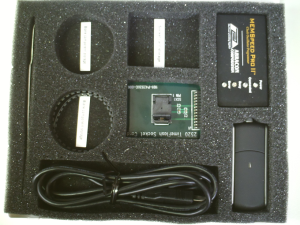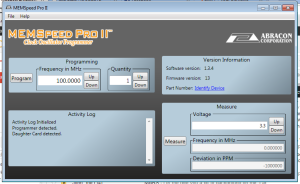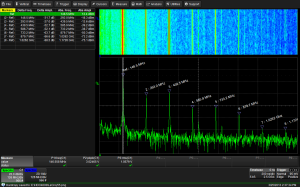When I saw that Abracon had reasonably priced programmable oscillators available, I knew I had to get some. There is a variety of different oscillators with different specifications available. I picked the Abracon ASDMB series MEMS (Micro Electro Mechanical System) oscillators [1] [2]. To be able to program these oscillators, one needs the MEMSpeed Pro II programmer and an adapter socket [3].
First off, a warning. MEMS oscillators aren’t the best performers when it comes to phase noise performance. So wherever phase noise plays an important role, these oscillators are probably not your best choice. But for that, MEMS oscillators or MEMS actuators / sensors in general are significantly less sensitive to vibrations and mechanical shock.
I got my MEMSpeed Pro II kit and the ASDMB adapter kit directly from Abracon. Any adapter kit comes with 50 blank oscillators. The case that the MEMSpeed Pro II comes in offers space for two adapter cards and plenty of blank ICs. There are numerous different oscillators with different parameters available [4].
Here’s a close-up of the MEMSpeed Pro II kit:
As you can see, there’s space for two socket cards and plenty of blank oscillators in the case. The USB drive contains all the software necessary for the programmer. Please make sure you install the software before you connect the programmer for the first time. The reason is that the programmer uses a proprietary USB driver that should be installed before the device talks to the PC for the first time.
The adapter card connects to the side of the MEMSpeed Pro II. Once everything is connected, one can hook up the programmer to the PC and start the software. The software is really self-explanatory. After entering the target frequency and clicking the “Program” button, the MEMS oscillator is programmed.
The “Measure” section of the software makes it possible to verify that the burn went correctly. However, it seems that the precision of this feature is not the best. It’s enough to make sure that the frequency is about right, but please don’t trust the last digit.
For an experiment, I programmed one of my ASDMB oscillators to the frequency 145.565, which is the national frequency for radio direction finding in the amateur radio community. I used my brand new Teledyne LeCroy HDO4024’s spectrum analyzer capabilities to obtain some data on the device’s performance.
As indicated above, the phase noise performance of MEMS oscillators is not the best. The following shot shows this clearly on the instantaneous spectrum and the historical spectrogram:
Next up is the harmonic output. The Teledyne LeCroy automatically marks harmonics and displays the level. Unfortunately, I entered a slightly off fundamental frequency (145.5 instead of 145.565). But the representation is still valid.
The ASDMB oscillators can operate between 1 and 150 MHz. They can be operated between 1.8 and 3.3 V and work well over the entire range. There are different temperature options available ad there are 3 sub-types available, which are designed for an output load of 10 kΩ and either 15, 25 or 40 pF of capacitive load. At 3.3 volts, the rise time is better than 2 nS.
Altogether, this is a very nice product and from now, on a must have in my lab. From now on, I will have almost any frequency available whenever I need it. The only way Abracon could make me happier would be by coming out with an MEMS VCO that can be pulled by an external voltage.
Links and Sources:
[1] ASDMB Datasheet, Abracon: http://www.abracon.com
[2] ASDMB Blank Oscillators, Mouser: http://www.mouser.com/
[3] MEMSpeed Pro II, Mouser: http://www.mouser.com/
[4] MEMS Overview, Abracon: http://www.abracon.com/
Westerhold, S. (2013), "Review: Abracon MEMSpeed Pro II Programmer / MEMS Oscillators". Baltic Lab High Frequency Projects Blog. ISSN (Online): 2751-8140., https://baltic-lab.com/2013/03/peview-abracon-memspeed-pro-ii-programmer-mems-oscillators/, (accessed: December 8, 2025).
- WebP-Images without Plugin - January 14, 2025
- Firewall Rules with (dynamic) DNS Hostname - January 14, 2025
- Restoring proxied visitor IPs from Cloudflare - December 26, 2024





David
Hi, So these are one-time programmable? The programmer is about 200 Dollars, what’s up with that? How does the programmer work? Anyway to figure out how to program these without the proprietary programmer?
The phase noise performance looks pretty bad, but then again you didn’t tell us what the noise floor of the FFT was. The dB/division looks like it is set to around 20 dB/div?
I don’t see much use for these as local oscillators due to the jitter/phase-noise and (to a lesser extent) harmonic content…
BUT, I’m very keen to know if these can be used as filters; maybe in a ladder filter, like tunable crystals! You’ve got a bunch of them, why not try to build a MEMS version of a crystal filter at say, 5.0688MHz, which for comparison purposes is a popular frequency for home-brew IF filters (5.0688MHz crystals are cheap). Maybe the Q of the MEMS devices is not good enough at 5MHz for a filter? If so, what about an RF front end filter at VHF frequencies? Or maybe 70MHz filter for an up-converting IF?
Man – wish I could experiment with these. You’re lucky…
Regards, David
Syed Raza
David: Since the MEMS Oscillators are totally integrated – Active devices (both MEMS resonator & oscillator circuitry), they can not be used as a Filter in the traditional sense.
In the future, if MEMS resonators were available stand-alone, there is a remote possibility to use them in a Filter scheme. However, the un-loaded “Q” of the MEMS resonator will be far inferior than the AT-Strip Quartz; so the selectivity will greatly suffer.
Regards,
Syed Raza
Director of Engineering
Abracon Corporation